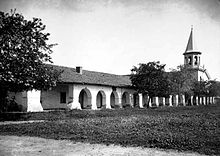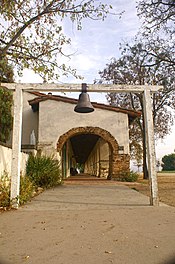Mission San Juan Bautista
 A view of the Mission San Juan Bautista and its three-bellcampanario( "bell wall" ). Two of the bells were salvaged by Father Nick Senf in 2009 from the original chime, which was destroyed in the1906 San Francisco earthquake. | |
| Location | 406 2nd Street San Juan Bautista, California95045 |
|---|---|
| Coordinates | 36°50′42″N121°32′09″W/ 36.845083°N 121.535889°W |
| Name as founded | La Misión del Glorios Precursor de Jesu Cristo, Nuestro Señor San Juan Bautista[1] |
| English translation | The Mission of the Glorious Precursor ofJesus Christ,Our Lord, SaintJohn the Baptist |
| Patron | Saint John the Baptist[2] |
| Nickname(s) | "Mission of Music"[3] |
| Founding date | June 24, 1797[4] |
| Founding priest(s) | FatherFermín Lasuén[5] |
| Founding Order | Fifteenth[2] |
| Military district | Third[6] |
| Native tribe(s) Spanish name(s) | Mutsun,Yokuts Costeño |
| Native place name(s) | Popeloutchom[7] |
| Baptisms | 4,106[8] |
| Marriages | 1,003[8] |
| Burials | 2,854[8] |
| Secularized | 1835[2] |
| Returned to theChurch | 1859[2] |
| Governing body | Diocese of Monterey |
| Current use | Parish Church |
| Reference no. |
|
| Website | |
| http:// oldmissionsjb.org/ | |
Mission San Juan Bautistais aSpanish missioninSan Juan Bautista,San Benito County, California.Founded on June 24, 1797, byFather Fermín Lasuénof theFranciscanorder, the mission was thefifteenthof the Spanish missions established in present-day California. Named forSaint John the Baptist,the mission is the namesake of the city of San Juan Bautista.
Barracks for the soldiers, a nunnery, theJose Castro House,and other buildings were constructed around a large grassy plaza in front of the church and can be seen today in their original form. TheOhlone,the original residents of the valley, were brought to live at the mission and baptized, followed byYokutsfrom the Central Valley. Mission San Juan Bautista has served mass daily since 1797, and today functions as aparishchurch of theDiocese of Monterey.
History
[edit]


Following its creation in 1797, San Juan's population grew quickly. By 1803, there were 1,036 Native Americans living at the mission. Ranching and farming activity had moved apace, with 1,036 cattle, 4,600 sheep, 22 swine, 540 horses and 8 mules counted that year. At the same time, the harvest of wheat, barley and corn was estimated at 2,018 fanegas, each of about 220 pounds.

FatherPedro Estévan Tápis(who had a special talent for music) joined FatherFelipe Arroyo de la Cuesta,at Mission San Juan Bautista in 1815 to teach singing to the Native Americans. He employed a system of notation developed in Spain that uses varied colors or textures for polyphonic music, usually (from bottom to top) solid black, solid red, black outline (sometimes solid yellow) and red outline (or black outline when yellow was used). His choir of Native American boys performed for many visitors, earning the San Juan Bautista Mission the nickname "the Mission of Music." Two of his handwritten choir books are preserved at the San Juan Bautista Museum. When Father Tapis died in 1825 he was buried on the mission grounds. The town of San Juan Bautista, which grew up around the mission, expanded rapidly during theCalifornia Gold Rushand continues to be a thriving community today.
The mission is situated adjacent to theSan Andreas Fault,and has suffered damage from numerousearthquakes,such as those of 1800 and 1906. However, the mission was never entirely destroyed at once. It was restored initially in 1884, and then again in 1949 with funding from theHearst Foundation.The three-bellcampanario,or "bell wall," located by the church entrance, was fully restored in 2010. An unpaved stretch of the originalEl Camino Real,just east of the mission, lies on a fault scarp.[9]
Although initiallysecularizedin 1835, the church was reconsecrated by theCatholic Churchin 1859, and continues to serve as a parish of theDiocese of Monterey.The mission includes a cemetery, with the remains of over 4,000 Native American converts and Europeans buried there.
The mission and its grounds were featured prominently in the 1958Alfred HitchcockfilmVertigo.Associate producer Herbert Coleman's daughter Judy Lanini suggested the mission to Hitchcock as a filming location. A steeple, added sometime after the mission's original construction and secularization, had been demolished following a fire, so Hitchcock added a bell tower using scale models, matte paintings, and trick photography at theParamountstudio in Los Angeles. The tower does not resemble the original steeple. The tower's staircase was assembled inside a studio.
See also
[edit]- Spanish missions in California
- List of Spanish missions in California
- Rancho San Justo
- Teatro Campesino
- USNSMission San Juan(AO-126)– aBuenaventuraClassfleet oilerbuilt duringWorld War II.
References
[edit]- ^Bennett 1897b, p. 153
- ^abcdKrell, p. 241
- ^Ruscin, p. 121
- ^Yenne, p. 132
- ^Ruscin, p. 196
- ^Forbes, p. 202
- ^Ruscin, p. 195
- ^abcKrell, p. 315: as of December 31, 1832; information adapted from Engelhardt'sMissions and Missionaries of California.
- ^Robert Iacopi,Earthquake Country(Menlo Park:Lane Publishing, 2004, 1971).
Sources
[edit]- Bennett, John E. (February 1897b). "Should the California Missions Be Preserved? – Part II".Overland Monthly.XXIX(170): 150–161.
- Forbes, Alexander (1839).California: A History of Upper and Lower California.Cornhill, London: Smith, Elder and Co.
- Jones, Terry L.; Kathryn A. Klar, eds. (2007).California Prehistory: Colonization, Culture, and Complexity.Landham, MD: Altimira Press.ISBN978-0759108721.
- Krell, Dorothy, ed. (1979).The California Missions: A Pictorial History.Menlo Park, CA: Sunset Publishing Corporation.ISBN0376051728.
- Leffingwell, Randy (2005).California Missions and Presidios: The History & Beauty of the Spanish Missions.Stillwater, MN: Voyageur Press, Inc.ISBN0896584925.
- Levy, Richard. (1978). William C. Sturtevant, and Robert F. Heizer (ed.).Handbook of North American Indians.Vol. 8 (California). Washington, DC: Smithsonian Institution. p. 486.ISBN0160045789.
- Milliken, Randall (1995).A Time of Little Choice: The Disintegration of Tribal Culture in the San Francisco Bay Area 1769–1910.Menlo Park, CA: Ballena Press Publication.ISBN0879191325.
- Paddison, Joshua, ed. (1999).A World Transformed: Firsthand Accounts of California Before the Gold Rush.Berkeley, CA: Heyday Books.ISBN1890771139.
- Ruscin, Terry (1999).Mission Memoirs.San Diego, CA: Sunbelt Publications.ISBN0932653308.
- Yenne, Bill (2004).The Missions of California.San Diego, CA: Thunder Bay Press.ISBN1592233198.
External links
[edit]- Mission San Juan Bautista– official site
- Early photographs, sketches, land surveys of Mission San Juan Bautista,via Calisphere, California Digital Library
- VertigoatIMDb
- Listing and photographs of churchat theHistoric American Buildings Survey
- Listing, drawings and photographs of missionat theHistoric American Buildings Survey
- Another view of the Mission Facade, circa 1980s
- Howser, Huell(December 8, 2000)."California Missions (105)".California Missions.Chapman UniversityHuell Howser Archive.
- U.S. Geological Survey Geographic Names Information System: Mission San Juan Bautista
- Mission San Juan Bautista CemeteryatFind a Grave
- 1797 establishments in Alta California
- 1797 in Alta California
- California Historical Landmarks
- Cemeteries in California
- Churches in San Benito County, California
- Churches on the National Register of Historic Places in California
- History museums in California
- History of San Benito County, California
- Museums in San Benito County, California
- National Register of Historic Places in San Benito County, California
- Religious museums in California
- Roman Catholic Diocese of Monterey in California
- San Juan Bautista, California
- Spanish Colonial architecture in California
- Spanish missions in California


